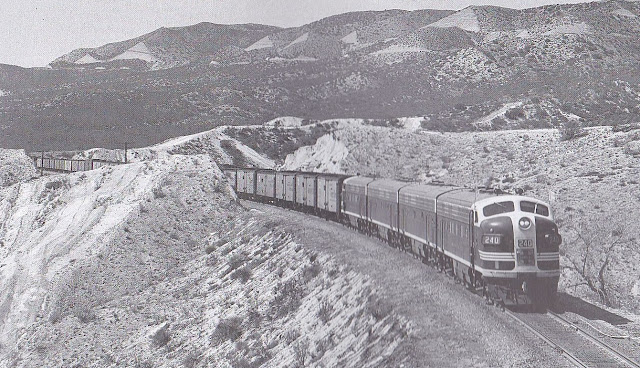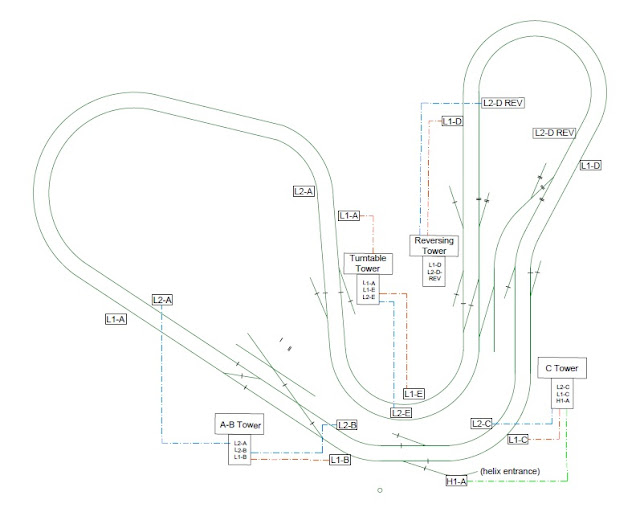This time we'll take a look at the Union Pacific's EMD E2, E3, and E6 diesels that ran through Victorville in the postwar years. Then we'll look at my minimal layout progress, except for revising track diagrams, and Craig Wisch's progress on his model of the Lime Rock plant.
UP got a streamlined round-nose E2 A-B-B set for the City of Los Angeles train in Oct. 1937, numbered LA-1, LA-2, and LA-3. In August, 1946, these were renumbered to 921A-922B-923B. In March, 1948, they were renumbered again to 984J-984BJ-984CJ.
In the postwar years these units often ran in mixed sets with the other early E units, and they were probably gone from Cajon Pass by the end of 1948.
Chard Walker got a shot of E2 #921A passing the Summit depot in March, 1947:
Then Stan Kistler got a good shot of the E2 set led by #921A in Los Angeles in June, 1947:
Here's one more shot of the E2 set #921A, crossing the Santa Ana River with the eastbound LA Limited in June, 1947, thanks to Donald Duke:
UP's next streamlined diesels were the EMD E3s, which came in March, 1939. They were an A-B set, numbered LA-5 and LA-6. In Feb. 1941 they became 5-M-1A and 5-M-1B. Then in Aug. 1946 they became 951A and 952B. In March of 1948 they became 991 and 992B.
The two E3 units, which could run in mixed sets with other early E units, were gone from Cajon Pass by 1953, if not sooner.
Here's a Louis Marre photo of a mixed set with E3 #951A leading an E6B and an E7B with the City of Los Angeles in LA in 1947:
Here we see the same E3 at San Bernardino, now renumbered to 991, as shot by Jack Whitmeyer in 1948 or later (note the new number boards and the loss of the portholes):
Jack Whitmeyer also got a nice color photo of E3 #991, probably on the same day:UP's final early E units were the EMD E6s.
In Aug. 1940, they got three E6 A-A sets numbered 7-M-1, 7-M-2, 8-M-1, 8-M-2, and 9-M-1, 9-M-2. In Aug. 1946 these became #953A, 954A, 955A, 956A, 957A, and 958A. Then in March of 1948, they became #992 through #997.
In Feb. 1941 the UP also got an E6 A-B-B set numbered LA-4, LA-5, LA-6. In
Aug. 1946 they became #924A-925B-926B. In March of 1948 they became
#987J-987BJ-987CJ.
The E6 units, which could run in mixed sets with other early E units, were probably gone from Cajon Pass by 1953.
In Oct. 1946 Stan Kistler shot E6 #924A with a mix of other E units in Los Angeles:
Here we see E6 #957A leading two more E units through Summit with the westbound LA Limited in 1947, thanks to Malcolm Gaddis:In this 1947 shot by Lewis Harris, an unidentified E6 set is being helped by 4-10-2 #5099 with an eastbound passenger train at Pine Lodge:
Now let's look at some of the HO models that have been made of these early E units.
Oriental Limited made the E2 units in brass. I have a 3-unit set that I got painted a couple of years ago. Here's a photo of two units that someone else got painted:
Overland Models made a painted brass E3 set (which I don't have), as seen here:Challenger Imports made a painted brass E6 set (which I don't have):Proto 2000 made a UP E6 set, as seen here (I have these):
More recently, Broadway Limited also made a UP E6 set:This concludes our coverage of UP's early E units on Cajon Pass.Now for a report on my minimal layout progress.
The week of Nov. 5 was an even slower week than usual, because I was fighting a cold all
week, plus I had to attend several meetings regarding family business.
On that Saturday I had to work most of the day at the annual swap meet run by
the Boeing Employees Model Railroad Club. I didn't find anything to
buy this time, but it was good to see so many old friends who attend
each year.
Craig
Wisch in Victorville began working on the central building of the
Lime Rock Co. plant. It has a central tower with a lower wing on each
side. Here are some drawings of the street side and a floor plan that
Wayne Lawson made for his own model:
Here's a photo from Craig showing how he was building a mockup of the main building:
I'm always fascinated by how he goes about building his amazing cardstock models!
I
also continued to correspond with Don Borden and Tim Fischer about some
details of the straight-line track diagram that you saw last time. I
came up with some major changes to make the diagram reflect the actual
blocks and yard limits more accurately, and today Don sent me a new
drawing with all the revisions incorporated.
To make it easier to read, this time I'm breaking the image into two halves. Here is the left half (along with some red-ink markups that I'm suggesting this week):
And here is the right half (with more red-ink markups for next week):
The biggest changes were to simplify the drawings of the
F Yard, the C Yard, and the A Yard. The A Yard now shows that the yard
is split into two blocks: Tracks A1-5 and A6-10, and it shows that the
turnouts at each end are controlled by two yard panels: A Yard Left and A
Yard Right.
Many thanks to Don Borden again for patiently slogging though all the changes I've requested!
George
Chambers had intended to visit me and help with the layout that Friday,
but I had to cancel that due to my cold. I was also intending to visit
Ray Rydberg later that day, but I had to cancel that too. We'll try
again later.
Bill
Messecar reported that he'd completed a 2nd water tank for the
Victorville section house scene, and now he's working on the third pump
house for the scene.
This past week I got over my cold, but I still had a lot of family business to attend to.
Craig
Wisch in Victorville continued to work on a cardstock model of the
central building in the Lime Rock Co. plant. He decided it would help a
lot to have some graph paper with the smallest squares being the size
of an HO foot, so he resized some graph paper and then used it to draw a
street-side profile of the main building:
Craig recommends this graph paper technique to all structure modelers.
He also began assembling the walls of the main building, as seen here:
Here's another view from the other side:
I enjoy corresponding with Craig by email several times a day -- we get along well.
I've
also been corresponding some more with Don Borden and Tim Fisher about the
staging tracks, block boundaries, reversing sections, track diagrams,
and control panel diagrams.
I've been working on improving the C Tower panel --
here are my markups for that, to make it more correct and more
user-friendly (more similar to the actual trackage):
I've also sent Don and Tim explanations for each of these changes.
I
had hopes of adding bus wire labels all around the layout edges this
week, but instead I only worked on improving my technique for making the
labels out of masking tape. I now measure and cut a 6" piece of tape,
then fold 2" of the tape back on itself to form a double-sided area that
I can write on (on both sides).
The
front side simply has the block label, such as "L1-A" or "L2-A," while
the back side gives information about the wire colors, such as: "Red -
Near - Active" (the red wires connect to the near rail, which is the active rail) and
"Black - Far - Common" (the black wires connect to the far rail, which
is the common rail).
The other two inches of tape is curled around the pair of bus
wires, with the sticky side out, to allow the labels to slide or to be
removed without a fight.
Here's a photo showing the front side of one label and the back side of another label:
Bill Messecar plans to visit me on Thursday, Nov.
30, when he will bring along the 2nd water tank and the 3rd pump house
he's been working on for the section houses scene. We plan to lay and
wire more tracks in the F Yard, so I need to cut and fit the short
tracks connecting those turnouts in the next two weeks.
If you can help too, please let me know.











































